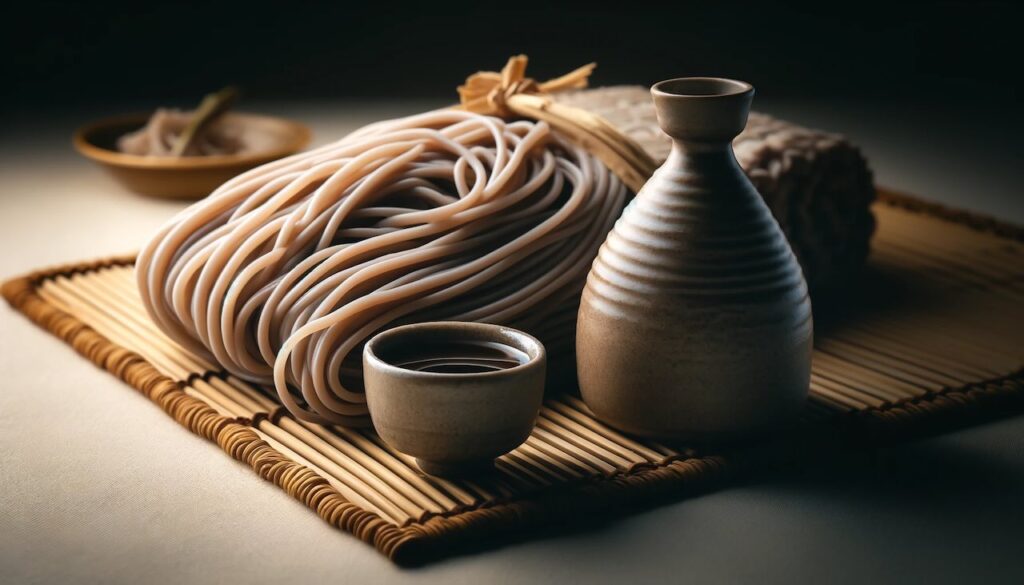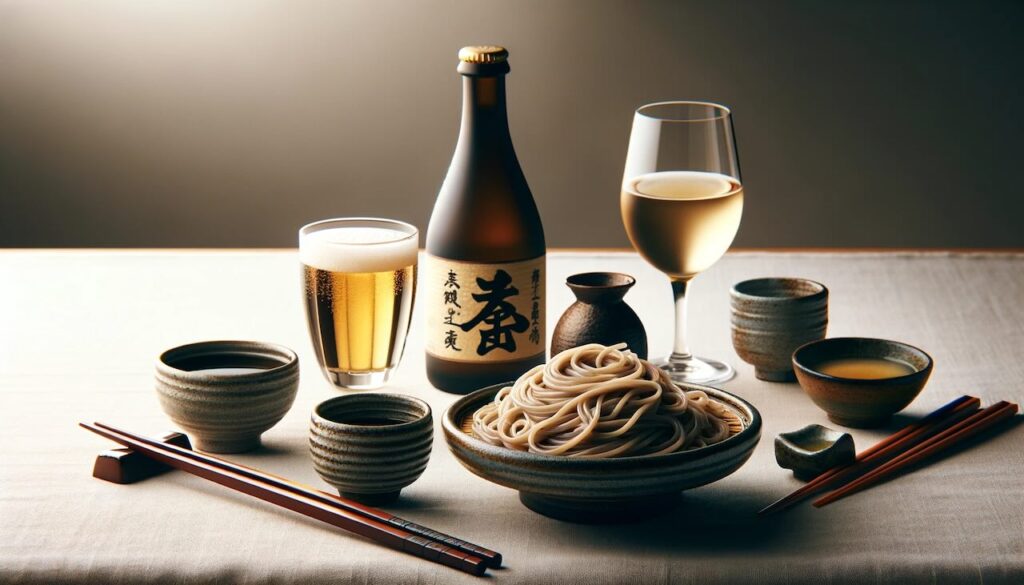When we think of soba shops today, we often imagine peaceful restaurants dedicated to serving refined buckwheat noodles. Yet the true origins of Japan’s soba shops reveal a very different beginning — one deeply connected to sake, late-night dining, and Edo-period drinking culture. At the center of this tradition sits sobagaki, a humble yet flavorful soba-based dish originally created as the perfect sake accompaniment.
Let’s explore how soba shops evolved from casual pubs to the noodle-focused restaurants we know today, while uncovering the enduring cultural bond between sobagaki and Japanese drinking traditions.
For a full overview of soba’s broader history, types, and cultural role, visit:
👉 The Complete Guide to Soba: Japan’s Ancient Noodle Tradition Explained
Soba Shops in the Edo Period: More Than Just Noodles
During Japan’s Edo period (1603–1868), soba shops — known as sobakiri-ya — were not yet the specialized noodle restaurants we see today. Instead, many operated similarly to izakaya (Japanese-style pubs), serving both simple meals and alcohol to a clientele seeking food and drink late into the night.
At the time, options for evening dining were limited due to curfews and regulations. Soba shops were among the few establishments permitted to remain open into the evening hours, making them natural gathering places for merchants, travelers, and city dwellers finishing their day. The warm, hearty comfort of soba paired perfectly with sake, and these shops became vibrant hubs of Edo nightlife.
Sobagaki: The Original Soba Snack for Sake
Sobagaki emerged as a popular dish within these early soba izakaya. Unlike soba noodles, which require cutting and precise handling, sobagaki is prepared by mixing buckwheat flour with hot water into a dough-like consistency, which is then shaped and served.
Its dense, slightly chewy texture and rich buckwheat flavor made it ideal for pairing with sake. The mild sweetness of buckwheat complemented the gentle acidity and complexity of sake, creating a balanced and satisfying drinking experience.
Historical Edo texts such as Morisada Manko and Edo Meibutsu Hyobanki praised sobagaki for its excellent compatibility with alcohol, reflecting its esteemed role as a classic sake snack.
Types of Sobagaki: Simple and Refined
There are two primary styles of sobagaki, both reflecting Japan’s appreciation for subtle variations:
Plain Sobagaki:
The traditional version, made from pure buckwheat flour and hot water. Its clean, nutty flavor allows the natural qualities of the buckwheat to shine.
Tororogaki:
This variation incorporates grated yam (tororo), lending the dough a softer, creamier texture and a touch of natural sweetness.
Sobagaki is typically served hot, as its texture can harden when cooled. It’s often accompanied by bold condiments such as soy sauce, wasabi, miso, or even grated daikon, each enhancing the pairing with sake.
For more on the different soba types and preparation styles, explore:
👉 Juwari Soba vs. Nihachi Soba: Understanding the Differences in Taste, Texture, and Nutrition
The Evolution of Modern Soba Shops
As Japan modernized during the Meiji period and beyond, soba shops gradually shifted their focus toward noodles rather than late-night drinking. Today, most soba restaurants highlight seasonal soba preparations, delicate dipping sauces, and noodle craftsmanship.
Yet even now, many traditional soba shops continue to offer sobagaki, especially during colder months when its warmth is particularly comforting. Modern chefs have even created creative variations, incorporating ingredients such as cheese, mushrooms, or seasonal vegetables, blending old traditions with new tastes.
Soba’s Enduring Role in Japan’s Food and Drink Culture
The story of sobagaki and soba shops reflects a broader truth about Japanese dining: the importance of balance, seasonality, and mindful enjoyment. What began as humble food for Edo merchants has grown into a refined culinary tradition celebrated for both its simplicity and cultural depth.
Soba’s unique versatility allows it to remain central in both casual and ceremonial dining. Whether you are enjoying chilled zaru soba in summer or a warm bowl of kake soba in winter, the cultural thread connecting soba to sake and Japanese hospitality continues to thrive.
For a full cultural deep dive into soba’s place in Japanese cuisine, visit:
👉 The Complete Guide to Soba: Japan’s Ancient Noodle Tradition Explained
Conclusion: A Flavorful Link to Edo Japan
Sobagaki may seem simple, but within its modest appearance lies centuries of history. Its origins as a companion to sake in Edo’s bustling soba shops remind us that Japanese food is never just about nourishment — it’s about community, tradition, and the quiet art of harmony.
The next time you enjoy a bowl of soba or sip sake, you’re participating in a cultural tradition that has gracefully adapted across generations — from Edo’s late-night streets to today’s soba artisans.


